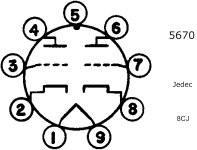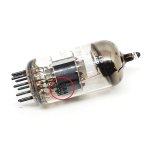A ECC88 and 12AT7/ECC81 from rebranders Hoges and Haltron respectively.
The Hoges ECC88 has a strong resemblance to Siemens tubes of the same type, like the getter installation and two-step support. But I can't recall seeing that first step metal plate being circular with no machining/cutting done to the part.




The Haltron ECC81 looks like the Philips family of tube construction. It very much resembles a Mullard (Philips branded) ECC81 I've got, but as the Haltron has four glass seams at the top this is apparently not possible. Another guess would be the Indian BEL factory who collaborated with Philips/Mullard. As a matter of fact, it reminded me of a BEL E81CC (Zaerix branded) that I brought to attention in another thread (https://www.diyaudio.com/community/threads/zaerix-e81cc.404144/). The look very much alike, except that the Haltron has ribbed plates versus smooth ones on the BEL/Zaerix.




Please chime in if you have any thoughts, suggestions!
The Hoges ECC88 has a strong resemblance to Siemens tubes of the same type, like the getter installation and two-step support. But I can't recall seeing that first step metal plate being circular with no machining/cutting done to the part.
The Haltron ECC81 looks like the Philips family of tube construction. It very much resembles a Mullard (Philips branded) ECC81 I've got, but as the Haltron has four glass seams at the top this is apparently not possible. Another guess would be the Indian BEL factory who collaborated with Philips/Mullard. As a matter of fact, it reminded me of a BEL E81CC (Zaerix branded) that I brought to attention in another thread (https://www.diyaudio.com/community/threads/zaerix-e81cc.404144/). The look very much alike, except that the Haltron has ribbed plates versus smooth ones on the BEL/Zaerix.
Please chime in if you have any thoughts, suggestions!
Last edited:
ECC88 would typically have been Mullard and used extensively in commercial electronics back in the day, I think it was purpose designed for TV tuners ? Very similar valve to ECC83 I think but capable of higher Anode current.
But I can't recall seeing that first step metal plate being circular with no machining/cutting done on the part.
That circular disc looks alien to me too. Maybe some new idea to stop crud from flashing the getter during manufacturing dropping into the other elements.
ECC88 and ECC83 are very different valves.... Very similar valve to ECC83 I think but capable of higher Anode current.
Very similar valve to ECC83 I think but capable of higher Anode current
"ECC88 and ECC83 are very different valves"
@mdr30 mentioned ECC88 and ECC81 - I was thinking about Mullard data having seen it in the past.
@jcalvarez what is your opinion of GE 5670 tube?
I like the pinout of the 5670, its clean.
-
Attachments
Last edited:
Look at the last three columns (mu, gm, ri), those are the most important bits. Maximum anode and heater voltages are of course important, but they are often similar.@mdr30 mentioned ECC88 and ECC81 - I was thinking about Mullard data having seen it in the past.
I have never used it. Curves look pretty linear. I recently bought a cheap Fatman iTube 182 (needs repairs, owner reported motorboating, could not fix it). It has four 5670, the previous owner replaced the original 6N3s, which is (wrongly, I think) advertised as a 5670 analogue. I will start working on it at some point , then I will know more about the 5670.@jcalvarez what is your opinion of GE 5670 tube?
Regarding the pin-out, I do not like it. It is different to virtually everything else out there. I understand when some double triodes designed for common grid operations for the top triode in cascode connection have an optimised layout, but not sure why the different layout of the 5670.
It is a tube originally designed for industrial applications, therefore it is probably very solid and reliable.
What does this have to do with the OP's post? He's not asking what the tubes are; they're very familiar types. He's asking where they might have been manufacturered.
The Hoges is really unusual. They've gone to extra trouble to fit that enormous getter-blocking plate, but they haven't bothered to secure the getter ring with two support rods. Like, were they going for premium ruggedization or not??
The Hoges is really unusual. They've gone to extra trouble to fit that enormous getter-blocking plate, but they haven't bothered to secure the getter ring with two support rods. Like, were they going for premium ruggedization or not??
Last edited:
Regarding the pin-out, I do not like it. It is different to virtually everything else out there. I understand when some double triodes designed for common grid operations for the top triode in cascode connection have an optimised layout, but not sure why the different layout of the 5670.
It is a tube originally designed for industrial applications, therefore it is probably very solid and reliable.
How can you not like the pinout? Its so logical no wires crossing over very easy to remember, I can remember it now: 1-H1 2-K 3-G 4-A 5-Screen 6-A' 7-G' 8-K' 9-H2
It was apparently designed in US for US military use in 1950's 1960's Said to be very reliable if used within specification. Both Triodes are identical not one preferred for some applications.
See this pdf - several datasheets:
Attachments
@Merlinb: Well, that's a good question. At least they were not aiming for "as cheap as possible" like many other rebranders. That getter-blocking plate is indeed unusal, I'll serach the web for something similar. Siemens ECC88 double stage getter has also a flat, broader stem, not the thin one in the Hoges. However, the Siemens ECC88 single stage getter has the thin stem!

There are no codes on either tube but the Haltron has a number moulded in the bottom glass:

A bit difficult to see, but the number is 29. Nothing decisive, but still...
There are no codes on either tube but the Haltron has a number moulded in the bottom glass:
A bit difficult to see, but the number is 29. Nothing decisive, but still...
What does this have to do with the OP's post? He's not asking what the tubes are; they're very familiar types. He's asking where they might have been manufacturered.
The Hoges is really unusual. They've gone to extra trouble to fit that enormous getter-blocking plate, but they haven't bothered to secure the getter ring with two support rods. Like, were they going for premium ruggedization or not??
The OP's ECC88, if its not China it will be India.
And if its not India it will be China for sure.
What makes you think that?The OP's ECC88, if its not China it will be India.
And if its not India it will be China for sure.
The disk, all the old Manufacturers got around whatever the problem was using technological knowledge of materials etc. whereas the Chinese and Indians don't bother with that if they can see an obvious easy practical fix.
The reason I ask is, I am wondering how common it was to import tubes from China before the 1980s when the socialist market started to open up. My guts says, not very common? I would have though India, eastern Europe, or USSR were more likely?
Very simple, it's different to almost everything else, it means tube-specific PCBs, wiring. Not a deal breaker, but I don't have to like it 🙂How can you not like the pinout?
Agreed, but not sure about the USSR, everything I see from there has some sort of mark on it that shouts out USSR the Cyrillic lettering for example.India, eastern Europe, or USSR were more likely
Very simple, it's different to almost everything else, it means tube-specific PCBs, wiring.
Hard to turn the clock back but all the manufacturers mixed up valve pinouts a long time ago and got locked into it. The 5670 pinout is so much easier to work with.
The designers of the 5670 probably didn't have the time for, or toleration for the possibility of errors caused by a mixed up pinout so they went straight to the only pinout that anyone could possibly draw for a double triode valve:
To be fair, the tubes we mostly use like the ECC88 have an anode on pin-6, right next to the heater on pin-5, which is not exactly ideal for hum! If only they could all be like the 5670.
That I can sign up to. Yes, it is well designed.If only they could all be like the 5670.
Yup, been trying, I'd love to be 25 again 🙂Hard to turn the clock back
Think you Haltron is a rebranded RFT. Not sure hundred percent, have to take a look in my boxes.
- Home
- Amplifiers
- Tubes / Valves
- Two mystery tubes: Hoges ECC88 and Haltron 12AT7

